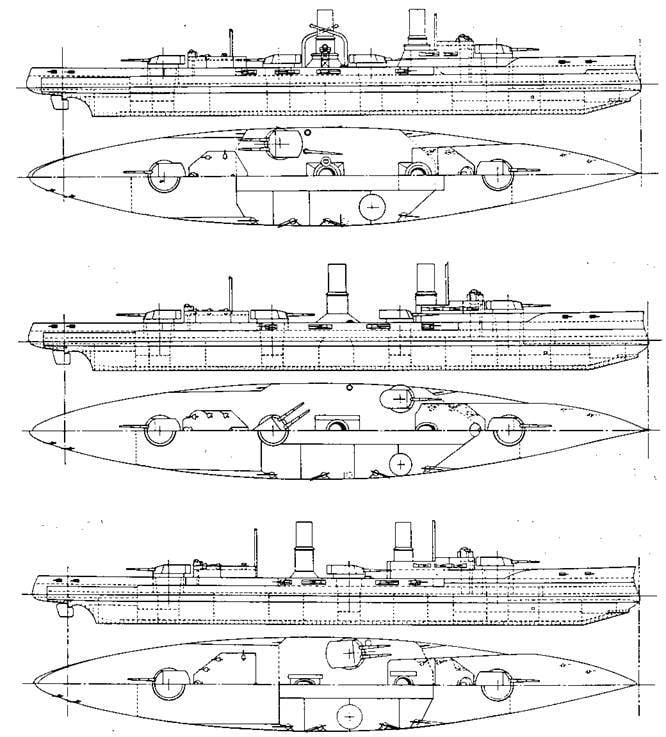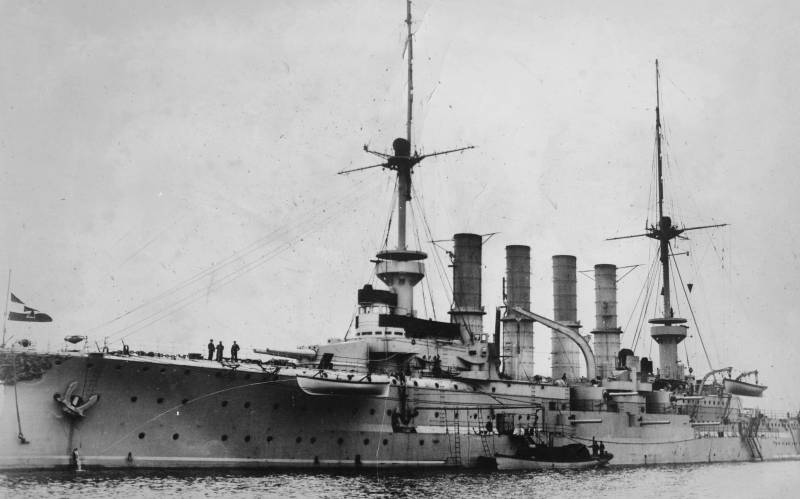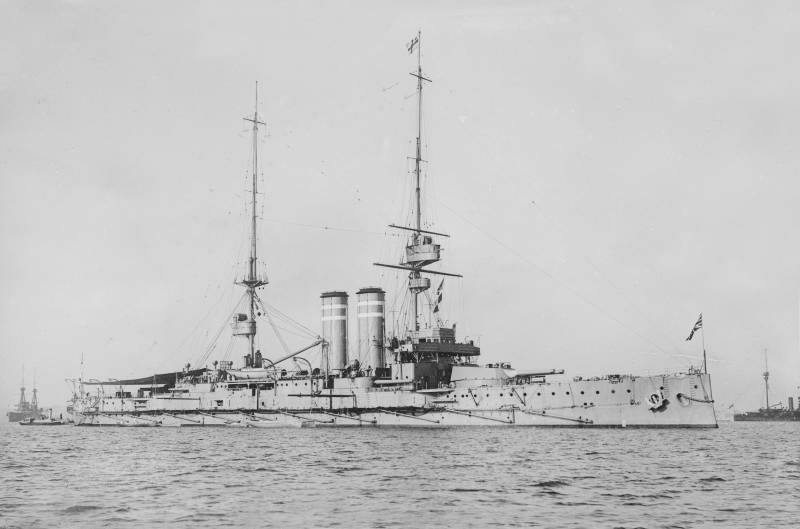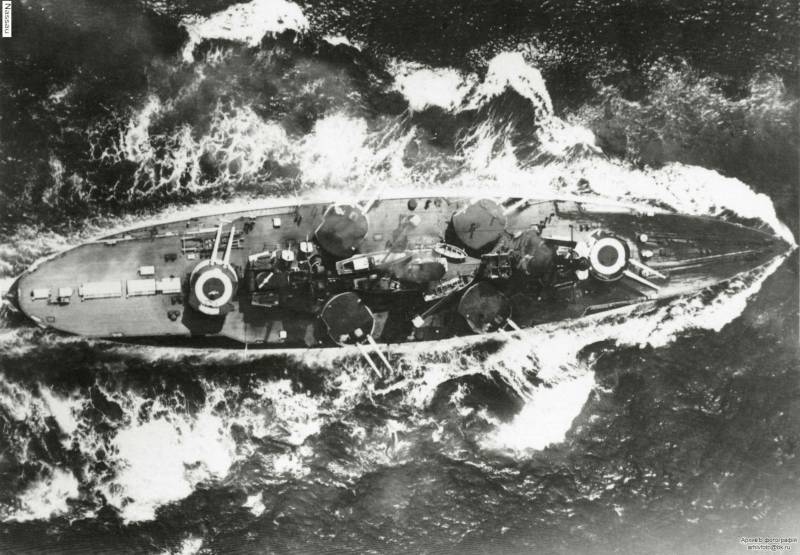Errors of the German shipbuilding. Big cruiser "Blucher"
In February and April, the British began the creation of Inflexible, Indomiteble and Invincible, announcing to the world the birth of a new class of warships - battle cruisers. And now, Germany, a year after these events, begins the construction of a very strange ship — the big cruiser “Blucher”, which in its fighting qualities was significantly inferior to the British ships. How could this happen?
For a start - a little stories. It must be said that German armored cruisers (with the exception of Fürsta Bismarck) in York are inclusive, if they differed in some way from ships of the same class of other maritime powers, it is the absolute absence of any distinctive features. "Facelessness and moderation" - this is a phrase that comes to mind when reading the performance characteristics of the German armored cruisers. "Furst Bismarck" was great because it was specially created for the colonial service, and here one could draw a number of interesting analogies with the British 2 class battleships, and the Russian Peresvet. But, starting with the "Prince Heinrich", the concept of armored cruiser construction in Germany changed radically - now the Kaiser fleet commanders decided that they needed an armored reconnaissance vehicle in a squadron, one for each squadron of battleships.
That is why armored cruisers in Kaiserlmarine were not numerous. From December 1898 g to April 1903 g was laid only five ships of this class - the "Prince Henry", two "Prince Adalbert" and two ships of the type "Roon". They had a moderate displacement - from 8 887 t "Prince Heinrich" to 9 533 t "Roona" (hereinafter we are talking about the normal displacement), moderate armament - 2 * 240-mm, and starting with "Princes Adalbertov" - 4 * 210-mm main guns and 10 * 150-mm medium-caliber, very moderate armor - the maximum thickness of the armor did not exceed 100 mm. The steam engines of these cruisers should have given them a very moderate speed of 20-21 knots, but in fact it turned out even worse. The “Prince Heinrich” “did not reach” the design 20 ties, showing the 19,92 ties, the “Prince Adalbert” and the “Friedrich Karl” with the planned 21 ties could develop only the 20,4 and 20,5 ties, respectively, and only on the ships of the “York” type did the curse fail speeds managed to prevail: both cruisers surpassed the planned 21 bonds, demonstrating 21,143 bonds (“Roon”) and even 21,43 bonds (“York”). Nevertheless, and without a doubt, against the background of the British and French ships of the same class, the German armored cruisers looked like very ordinary walkers.
On this unhurried progressive development of the German armored cruisers ended. The following ships of this class, the Scharnhorst and Gneisenau, again marked the change of concept and differed significantly from the ships of the previous series.
First, the Germans once again considered that they needed heavy ships for the colonial service, and therefore they tried to increase not only seaworthiness, which, generally speaking, the previous armored cruisers were very good, but also speed (up to 22,5 knots). It was a rather interesting approach: the Germans considered that high speed was an attribute of the ocean raider, and not the scout in the squadron.
Secondly, the Germans strengthened their booking by increasing the maximum thickness of the armor belt from 100 to 150 mm.
Third, they increased the power of the artillery, adding four more of the same 210-mm guns to the dungeon to the two two-gun turrets of the 210-mm guns. In order to somehow compensate for the increase in weight, and not to waste precious tons of displacement for additional armor to expand the casemates under the new guns, the designers reduced the average caliber to the same number of barrels, leaving only six 150-mm guns.
All of the above led to the appearance of quite good armored raiders, but, of course, this quality improvement led to an increase in the size of ships. The last classic armored cruisers of Germany, which became the Scharnhorst and Gneisenau, became significantly larger than the Yorks, having a normal displacement of 11 600 - 11 700 t. The first 28 of December 1904 g laid the Gneisenau, and after only six days - January 3 1905 g, the Scharnhorst tab was held. However, the next armored cruiser of Germany, the Blucher, was laid only on February 21 1907 g, i.e. more than two years after the previous Scharnhorst. Why did this happen?
The fact is that the construction of ships in Kaiser Germany was carried out in accordance with the Law on navy", In which the laying of new warships by year was painted. At the beginning of the century, the second law, approved in 1900, was in force, and with the adoption of armored cruisers, a small problem arose.
Strictly speaking, there were no armored cruisers in Germany, but there were “big cruisers” (“Große Kreuzer”), which, in addition to the armored ships themselves, also included large armored cruisers. Alfred von Tirpitz, in those years not yet a grand admiral, but a state secretary of the naval department, wanted to get a shipbuilding program from the Reichstag that would provide Germany with 1920 a fleet of 38 battleships and 20 large cruisers. However, the Reich did not agree with such an ambitious plan and the program was slightly curtailed, leaving only the 14 large cruisers.
Accordingly, their construction schedule would include laying one keel per year up to and including 1905 g, in which case the number of large cruisers would be exactly 14, including:
1) Armored cruiser "Kaiserina Augusta" - 1 unit.
2) Armored cruisers of the type "Victoria Louise" - 5 units.
3) Armored cruisers from Furst Bismarck to Scharnhorst - 8 units.
After that, the construction of large cruisers provided for a pause to 1910 g, because the following cruisers should have been laid only to replace those who had already served their time, i.e. for systematic replacement of ships in order to constantly maintain their numbers at the level of 14. Accordingly, after the laying of the Scharnhorst, the “big cruisers” were scheduled for long shipbuilding holidays. However, the situation was corrected by the same indefatigable von Tirpitz - in 1906 r he “pushed through” the return to the original 20 “big cruisers” in the fleet, and their construction resumed.
And here a number of questions arise. The fact is that the overwhelming majority of sources and publications describe the birth of the ninth armored cruiser of Germany like this: the Germans knew about the construction of the Dreadnought and knew that the British had laid the new armored cruisers of the Invincible type to it. But the British managed to misinform the Germans, and they believed that the Invincibles were similar to the Dreadnought, only with 234-mm artillery instead of 305-mm. Therefore, the Germans, who had nothing to do, laid a lightweight resemblance to the “Nassau” with 210-mm cannons, and they lost because of the 210-mm “Blucher”, of course, much inferior to the 305-mm “Invinsible”.
The logical version, in terms of time, everything seems to be the same - but why then did the same Mujenikov mention in his monograph that “Blucher” was designed in 1904-1905, when no one had heard of any “Invincibles”? And the second question. If von Tirpitz obtained permission for the resumption of the construction of the new “big cruisers” in 1906 g, then why was “Blucher” laid only at the beginning of 1907 g? Unfortunately, in Russian sources there are no details of the design of “Blucher” and we can only guess at different degrees of reliability.
From the publication to the publication cited common phrase that the first German dreadnoughts "Nassau" were designed after it became known about the performance characteristics of the "Dreadnought":
In fact, everything was “a little” wrong - the Germans came to the “dreadnought” concept and to “Nassau” on their own, although not in the way that the British. In the first years of the twentieth century, the short-term era of fascination with rapid-fire average caliber artillery was coming to an end. The world began to realize that 152-mm projectiles are too weak for even the multitude of their hits to cause significant damage to the battleship. Therefore, there were ideas to increase the average caliber, or supplement it with larger, 203-234-mm guns. At one time, the first version seemed preferable to the Germans, and they increased the average caliber from 150-mm to 170-mm on their armadillos of the Braunschweig and Deutschland type. The British followed a different path, laying a series of battleships King Edward VII, in which, instead of the standard for British battleships of a dozen six-inch guns, 10-152-mm and 4-234-mm guns were installed.
The Germans could not ignore such powerful guns from their rivals, and now, at the beginning of March 1904, the German designers are developing a new design of an armored ship with an even more reinforced average caliber. With a quite moderate displacement of 13 779 T, the ship was armed with four 280-mm guns in two towers (in the bow and stern) and eight 240-mm guns in four towers in the middle of the ship, two towers on each side. In other words, the artillery in this project was located along the same lines as the towers at Nassau, but included both 280-mm and 240-mm guns. The 150-170-mm artillery system was not envisaged by the project - only the anti-mine battery from 16 88 guns. The steam engines were supposed to provide the ship with speed in 19,5 nodes.
The Kaiserlmarine management generally liked the project, but ... they did not perceive the 240-mm guns as a medium caliber, it is quite logical that the battleship offered to their attention has two main calibers. Therefore, they proposed to rework the project in order to eliminate the “two-headed caliber” of the battleship. It is in this, not quite usual way, Germans ... what is most interesting, the concept of “all-big-gun” was never achieved.
The revised project was submitted to 1905 for consideration in October, and it looked extremely interesting. The designers replaced the two-gun 240-mm turrets with single-gun 280-mm: thus, the battleship received eight 280-mm guns from which six could be fired at one side. However, pulling up the “second main caliber” to the “first”, the Germans were not at all going to give up the medium caliber and returned eight 170-mm guns to the ship, marking them in dungeons, which, in fact, does not allow this project to be attributed to “all- big-gun. Mine artillery consisted of twenty 88-mm cannons. Displacement increased to 15 452 t.
In principle, already at this stage, we can say that the Germans have designed their first, even a very weak dreadnought. But, after reviewing the submitted 1905 draft of a thousand-ton ship with eight 15,5-mm guns at the end of 280, the fleet rejected it ... due to the weakness of the onboard volley, in which only 6 guns of the main caliber were involved and which should have been made more powerful. After this, the requirements of the fleet decided to remake the side towers from one to two guns, which suggested itself, and ultimately the Germans did so. In 1906 r, a project of G.7.b appeared, a dozen 280-mm guns, which later became Nassau.
Thus, even before they learned the characteristics of the English Dreadnought in Germany, the Germans arrived at the concept of a heavy ship, at a speed of about 20 units armed with more than eight 280-mm main caliber guns. Why, then, did some delay arise with the laying of new battleships? Prior to this, the Germans, in full compliance with their “Law on the Fleet”, annually laid the keels of new battleships, but they laid down their last squadron battleship in 1905 (Schleswig-Holstein), and the first dreadnought was only in July of 1907.
The point here is not at all in the Dreadnought, but in the fact that a number of reasons hindered the immediate transition from battleships to battleships of the new type in Germany. The increase in the number of trunks of the main caliber demanded a sharp increase in displacement, and in fact the ships do not appear from nowhere and should not leave the factory wall to nowhere. Before the laying of the Nassau, the Germans created very limited size battleships, their shipyards and naval bases were focused on the construction and operation of ships with a normal displacement not higher than 15 000 t. To build and maintain basing heavier ships, shipyard upgrades were required, dredging work, etc. Nobody in Germany wanted to start creating giant battleships, in comparison with previous battleships, until there was confidence that the country could build and operate new ships. But all this required money, and after all, in addition to this, new battleships had to significantly surpass the cost of the old squadron battleships, and this too had to be somehow settled.
Why in the article devoted to the armored cruiser "Blucher", we devote so much time to the first German dreadnoughts? Only in order to show the respected reader that all the necessary prerequisites for creating the “Blucher” in the form in which it was built, already existed in 1904-1905. Already during the design of the Scharnhorst and Gneisenau, the Germans had an understanding of the need to strengthen the artillery of their armored cruisers, and this was due to the increase in the number of 210-mm cannons. In 1904 r in Germany, they thought of placing the 6 towers according to the rhombic scheme, in 1905 r - placing the guns of one (280-mm) caliber in these towers, and at the same time they came to the conclusion that even eight guns arranged according to this scheme are all it is not enough.
But why did the Germans undertake to design their next armored cruiser on the eve of shipbuilding holidays, because after the Scharnhorst, according to the Fleet Law, new ships of this class could not be built before 1910? Von Tirpitz writes in his memoirs that the Reichstag rejected the construction of 6 cruisers "because he had to reject something" and that during the ensuing debate it was decided to return to re-examine this issue in 1906. In other words, von Tirpitz obviously expected to return 6 "big cruisers" in the shipbuilding program, and therefore, it is likely that he wanted to have a finished draft of the new ship for 1906. So that it was possible to build it without delay - as soon as permission from the Reichstag is received.
“But please!” The attentive reader will note: “If von Tirpitz was in such a hurry to build cruisers, then why did Blucher not be laid in 1906, but only in 1907 g? Something does not agree here! ”
The thing is, the construction of ships in Germany was a little different, as, for example, in Russia. We usually started building a ship's laying (although the official date of laying was not always the same as the actual start of work). But the Germans had a different way - the official tab was preceded by the so-called “Production preparation and stocks”, and this preparation was very long - for example, for the Scharnhorst and Gneisenau it was about 6 months for each ship. This is a very long time for preparatory work and it seems that during the “pre-production and the stocks,” the Germans also carried out work on the actual construction of the ship, that is, the date the ship was laid out did not coincide with the start date of construction. This happened quite often and in other countries - for example, the “Dreadnought” built “in one year and one day” was actually built much longer. Simply, the moment of the official bookmark, from which the notorious “one year and one day” is usually counted, occurred much later than the actual construction of the ship began - in fact, it was not 2 of October 1905 g (the date of the official bookmark) that began to create, but at the beginning May 1905. Thus, the period of its construction was not 12 months and 1 day, but 20 months, if we consider the end of the construction not the date the ship received the fleet, but the exit date for the sea trials (otherwise it should be admitted that the Dreadnought was building the 23 month ).
Hence the interesting consequence. If the author of this article is right in his assumptions, then compare the terms of construction of domestic and German ships "head on", i.e. from the dates of the bookmark to the date of commissioning wrong, because in fact the German ships were built longer.
But back to the "Blucher". Unfortunately, Mujenikov does not indicate the presence and duration of “pre-production and stocks” for “Blucher”, but assuming the existence of this preparation for months in 5-6, by analogy with previous armored cruisers, then, taking into account the date of the bookmark “Blucher” ( 21.02.1907), it is obvious that they started its creation much earlier, i.e. back in 1906. Therefore, the Germans didn’t have any "tetanus" - von Tirpitz convinced the Reichstag of the need for 20 "big cruisers" for the fleet, and soon after that construction work began on the "Blucher"
Nevertheless, I would like to note that the foregoing about “Blucher” is not a collection of reliable facts, but the thoughts and conjectures of the author, which could only be clarified by working in the Bundesarhivas. But in any case, we see that Muzhenikov’s words that the Blucher project was created in 1904-1905 did not contradict the general trends of the development of the German navy. And if the author is right in his assumptions, the Invincible project did not have a special influence on the development of Blucher, since the Germans designed their ship long before information about the first British battlecruisers appeared.
The British desire to present the matter as if both Nassau and Blucher were created under the influence of the achievements of British naval thought still, most likely, has no basis. In the case of Nassau, it can be argued for sure that what happened before Blucher - in the opinion of the author of this article, this was the case. The Germans quite independently came up with the idea of an armored cruiser having at least 4 two-gun turrets of 210-mm guns and developing speed of 25 knots.

Then, when the "reliable" data on the Invincible became known - allegedly, this cruiser is a copy of the Dreadnought, only with 234 artillery, the Germans probably congratulated themselves on how great they guessed the development trends of the "big cruisers" and approved for the "Blucher" six 210-mm towers located in the rhombic scheme, as in "Nassau". And then, when the true tactical and technical characteristics of the Invincible ships became clear, they clutched their heads, because, of course, the Blucher was not their equal.
To be continued



Information